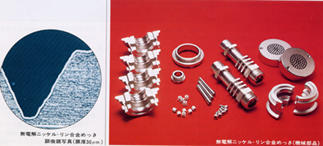Electroless nickel-phosphorus plating can give conductivity not only to conductive materials, such as metals and carbon-based materials, but also to plastics (resins), ceramics, paper, fibers, and most other non-conductive materials. Since it is not electroplating, plating thickness is uniform for all parts, including inner faces and micropores, irrespective of product shape. Dimensional accuracy is particularly excellent. It is used for ceramic devices, ceramic capacitors, and many other electronic parts (electrode formation).
| Type of plating | Features | Characteristic value |
|---|---|---|
| Ni-P content – 5% (low phosphorus) |
- Improvement of adhesion properties (ITO substrates, polyimides, glasses) - Alkali resistance - Hardness (as-plated Hv = 700, heat-treated Hv = 800 – 900) - Chemical-resistant parts |
Pb-free
 |
| Ni-P content 5 – 10% (medium phosphorus) |
- Excellent corrosion resistance - Hardness (as-plated Hv = 500, heat-treated Hv = 800 – 1000) - High versatility, covering iron-based shafts and pistons, plastic parts (giving conductivity), contacts, substrates, etc. |
Pb-free
 |
| Ni-P content 10% – (high phosphorus) |
- Acid-resistant - Non-magnetic (after heat treatment) - Primary plating of hard disk substrates, chip resistors |
Pb-free
 |

Electroless Ni-P plating
(From “Denki Mekki Gaido” edited by Federation of
Electro Plating Industry Association, Japan)
Types of plating
Materials & uses